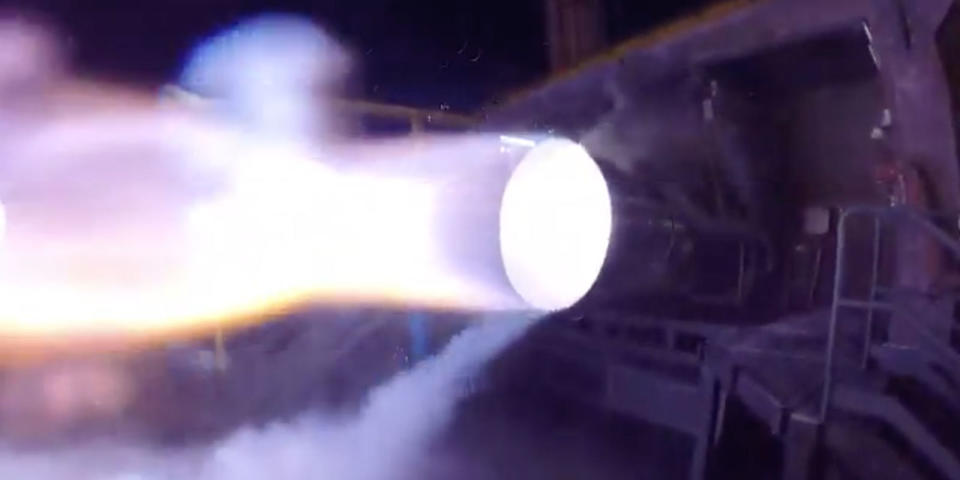Blue Origin Test Fires Powerful Heavy Lift BE-4 Rocket Engine

Blue Origin conducted a landmark test on Wednesday, firing up the Blue Engine 4 (BE-4) rocket engine for its very first hot-fire test. BE-4, powered by liquid oxygen and liquid methane propellants, has attracted lots of attention as it promises to be the most powerful American-built rocket engine in decades. Blue Origin plans to use the engine on its upcoming New Glenn heavy-lift rocket, but the BE-4 could find a more immediate home boosting United Launch Alliance's new flagship rocket, called Vulcan.
First hotfire of our BE-4 engine is a success #GradatimFerociter pic.twitter.com/xuotdzfDjF
- Blue Origin (@blueorigin) October 19, 2017
The hot-fire at Blue Origin's testing ground near the town of Van Horn in West Texas saw the spaceflight company crank the BE-4 up to 50 percent power for three seconds, according to Eric Berger at Ars Technica. Blue Origin began work on the engine back in 2011, but only announced the development program to the public in 2014.
The Blue Engine 4 is the first large rocket engine developed with almost entirely private money, making this test all the more impressive. Designed to pump out 550,000 pounds of thrust at sea level, the fully reusable BE-4 heralds Blue Origin's entry into the deep space and heavy launch games. More powerful than the Space Shuttle main engine and SpaceX's Raptor engine (which is currently under development for the Big Falcon Rocket) the BE-4 could very well become the premier American rocket engine for heavy launches, both commercial and military.

Blue Origin, the spaceflight company founded by billionaire Amazon CEO Jeff Bezos, initially focused on developing a small, reusable, suborbital rocket called New Shepard. The company made history in November 2015 when it launched and landed the New Shepard rocket, the first time a rocket booster returned from space for a vertical landing. Blue Origin would go on to fly and land that same rocket four more times.
But New Shepard is just a suborbital rocket designed to take tourists to the edge of space for a quick look around the planet. The BE-4 is for bigger missions. Blue Origin plans to use the engine on its New Glenn rocket, a reusable, heavy-lift rocket to carry satellites and crew to low Earth orbit and beyond. New Glenn will come in a two- and three-stage variant, and the BE-4 would propel both the first and second stage of the 270-foot-tall rocket (make it 313 feet for the three-stage version). Blue Origin optimistically plans to fly New Glenn for the first time in 2020.

However, Bezos' company plans to put the BE-4 to work before that. Back in April 2015, United Launch Alliance-a joint venture of Boeing and Lockheed Martin that had launched pretty much all government satellites before SpaceX came to town-announced its plans to use the BE-4 in its upcoming Vulcan rocket. The announcement came as somewhat of a shock, as Aerojet Rocketdyne had traditionally build the rocket engines for not only ULA but nearly all significant American rocket engines in history, including the Space Shuttle main engine and the F-1 that powered the Saturn V. Rocketdyne is offering the AR1 liquid kerosene/oxygen engine for Vulcan as well, but assuming no snags in development, ULA has expressed preference for the BE-4.
The two primary rockets ULA operates today are the Atlas V and the Delta IV. The Atlas V uses the Russian-built RD-180 engine, while the Delta IV uses Aerojet Rocketdyne's RS-68 engine. The RS-68 and the Delta IV as a whole are incredibly expensive to build and fly, and ULA has expressed interest in mothballing the launch vehicle and relying on the Atlas V. However, the military, which has almost exclusively relied on ULA for rocket launches in the past decade, was worried about only having the less-powerful Atlas V at its disposal. The Vulcan rocket is ULA's solution to build a cheaper launch vehicle to replace the expensive Delta IV and, ultimately, the Russian-powered Atlas V as well.

Aerojet Rocketdyne has lobbied Congress to pressure ULA to use the AR1, which has already received more than $200 million in federal funding, according to Ars. The lobbying prompted multiple congressmen to write to the Air Force in March, expressing concerns that the BE-4 is "unproven at the required size and power." The next month, Blue Origin suffered a setback when a BE-4 powerpack exploded on the testing rig.
But through it all, ULA has retained confidence in Jeff Bezos' rocket startup and the BE-4 program. The engine selection for Vulcan is not official, but barring any significant setbacks to BE-4 testing, the rocket will likely go with Blue. The first Vulcan launch is expected no earlier than 2019, and both the BE-4 and rocket hardware still have significant milestones to complete before that bird is ready to fly.
United Launch Alliance was recently shaken by SpaceX, which undercut ULA for national security launch contracts. The rocket giant of Boeing and Lockheed's making is looking to get back into the game with Vulcan. After this first successful hot-fire test, it looks like Blue Origin could be the firm to supply the engine. One thing is for sure, though-private spaceflight has never been so competitive, and at the breakneck pace these companies are trying to climb over each other, with billionaires and government contracts footing the bills, humanity's voyage to space hasn't been this thrilling in decades.
Source: Ars Technica
You Might Also Like
